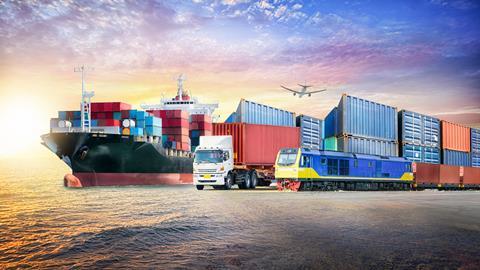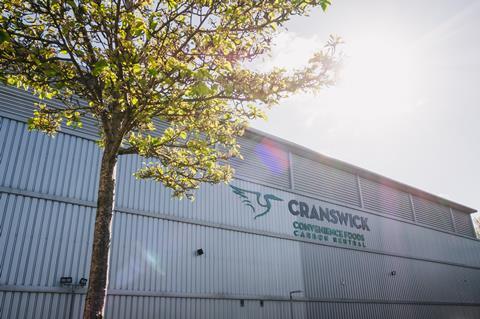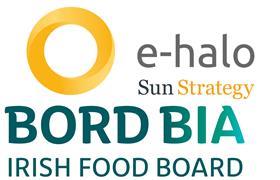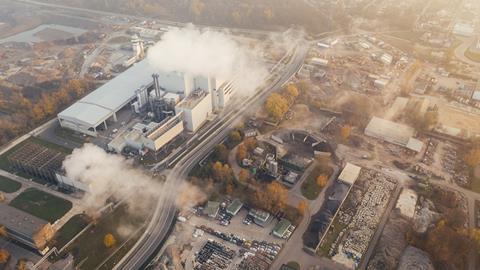We’ve got used to food and drink companies announcing carbon-cutting initiatives across production and retail. But reducing indirect Scope 3 emissions – everything from sourcing ingredients to how consumers dispose of packaging – is a huge challenge. So how are businesses measuring their emissions and taking action?
In November, thousands will descend on the city of Glasgow. World leaders, top scientists, NGOs and business CEOs will join crowds of placard-waving campaigners, all there for the UN’s latest annual global gathering on climate change: COP26.
Some 30,000 people representing more than 200 nations are expected to make their way to Scotland’s biggest city for the event. There, those countries signed up to the United Nations Framework Convention on Climate Change are expected to set out bold plans to curb their greenhouse gas emissions (GHGs).
Among them, of course, will be this year’s host, the UK. In June 2019, the UK’s Climate Change Act was amended to commit to a net zero target by 2050, making it among the first countries to enshrine such a goal in law. Whether or not the UK is on track to achieve its plan is hotly debated. But there is little dispute that faster progress in the food industry – responsible for more than a quarter of GHGs globally – will be critical to its success.
“If we want to fight climate change, preserve natural resources, mitigate emissions and bring a commitment to the health of people and the planet and the sustainability targets, we need to definitively integrate the food systems with the climate agenda,” said FAO director general José Graziano da Silva in March, as activists pushed to have food production higher on the agenda at November’s gathering.
For the most part, politicians, consumers and investors agree. Which is no doubt why the food industry is now awash with green labels, boardroom targets, and talk of ground-breaking carbon-cutting initiatives.
“Where companies are genuine about understanding their emissions, Scope 3 is where they should be looking”
But the reality is that the real work on GHGs often isn’t fit for rousing speeches on international stages, or feel-good marketing campaigns for PR-hungry brands. It is painstaking work, of which the industry is currently only scratching the surface. And few things capture that better than Scope 3 emissions.
Even the most sustainability-savvy consumers are unlikely to have the different categories of GHGs on the tip of their tongue. But according to the leading GHG Protocol Standard – the standardised framework for measuring and managing emissions – there are three categories that must be recognised by businesses. Scope 1 covers the direct emissions from sources they own, such as those from their own manufacturing processes. Scope 2 is indirect emissions from these same sources, such as the electricity used to power that manufacturing facility. Scope 3, meanwhile, covers all other indirect emissions, so vast in scope that it has been split into 15 sub-categories.

Spanning everything from sourcing and third-party logistics to packaging and how much waste is created at household level, Scope 3 emissions invariably make up the bulk of emissions for any food business. Fail to address them, and the industry will only ever scratch the surface on GHGs.
“Scope 3 is pretty fundamental to everything,” says Tom Cumberlege, associate director at The Carbon Trust. Take a food processor handling a portfolio of different SKUs. Each one is likely to contain multiple different ingredients, each with their own individual carbon footprint, depending on how it’s produced, sourced and transported. That same product will be packaged in materials that have generated GHGs prior to reaching the processing facility. Once bought by a consumer, the product itself may sit in a fridge until it goes past its use-by date and needs to be chucked away, creating yet more GHGs. All of these elements will fall into the category of Scope 3.
The same goes for retail. When in 2019 The Co-op shared a full breakdown of GHGs across its own business, it appeared to show that 92% of total emissions would be classed as Scope 3, with 71% from sourcing ingredients alone, 8% from manufacturing and 10% from packaging and transporting products.
Despite their crucial nature, Scope 3 emissions currently fall outside the scope of mandatory reporting in the UK for large businesses – and therefore too often outside the scope of discussion. This needs to change, according to Muryel Boulay, senior environmental sustainability consultant at Scala. “Where companies are genuine about understanding their emissions, [Scope 3] is where they should be looking. It’s a must, it’s no longer an option. And I want to believe that compulsory reporting is going to extend to Scope 3 very soon.”
Action underway
The good news is that awareness of and action on Scope 3 emissions is, slowly, starting to happen. Via its Courtauld Commitment, for example, Wrap has convened a supply chain GHG Working Group, with engagement from more than 100 organisations so far, including retailers, foodservice, supply chain businesses, farming bodies and government departments. Leading that work for the non-profit is its newly appointed head of climate action strategy Karen Fisher.
According to Fisher, the motivations for businesses engaging more with Scope 3 and the working group are threefold. “One is that it comes at a time when businesses are starting to set themselves net zero targets or science-based targets, and with that comes a requirement to be measuring their emissions,” she says. “We’re in a place now where everyone recognises that to have a meaningful target, it needs to include Scope 3 emissions.”
That was the case at Carlsberg Marston’s Brewing Company, which says it was the first brewer to set science-based targets aligned with the Paris Climate Agreement in 2017. That required “in-depth assessments of our Carbon Emissions across the entire value chain”, says sustainability manager Pete Statham. That has included collecting data on its Scope 3 emissions, with an analysis in 2020 including primary data from suppliers representing 60% of its spend, “covering our value chain from raw materials to point of sale”.

The second motivation behind taking action on Scope 3 is growing pressure from investors. In 2015, the Financial Stability Board – an international body that makes recommendations on the global financial system – created the Task Force on Climate-related Financial Disclosures (TCFD), which requires organisations to share information on the risks that climate change presents to their business, including GHGs. Though currently a voluntary requirement, the UK is expected to become the first G20 country to make these disclosures mandatory by 2025.
“The physical risks of climate change are already apparent when we look at the news, but when you look at the projections, it’s really quite scary from a financial risk perspective,” says Cumberlege. “Most businesses are still looking at that maximum five-year timeframe, but the investor community is looking at a much longer scale, as the growing pressures on certain sectors and businesses become more apparent.”
Which ties in with the third source of motivation. “That’s around being able to provide information to consumers,” says Fisher.
“We know we will need to widen the scope of collaboration and pick up the pace with the wider market”
Increasing shopper appetite for this information led Quorn to add carbon footprint labels to its range in 2020, for instance, though calculations began all the way back in 2011, points out its sustainable development manager Tess Kelly. “Scope 3 emissions have always been critical to our carbon footprinting strategy,” she says. “We take a ‘farm to fork’ approach to the numbers, including the waste disposal, use of sold products, upstream and downstream transportation and distribution, which are all part of Scope 3. We want shoppers to see the entire lifecycle of the product and assess the full climate impact of their food choice.”
Still, Quorn is the exception rather than the rule. The majority of food businesses are yet to measure and take action on Scope 3 emissions. Some of which is down to apathy. And some of which is down to the huge challenges Scope 3 emissions present.
“Scope 3 emissions are, by nature, emissions you do not directly control as a company,” points out Marjolein Hanssen, consumer foods analyst at Rabobank. “You are indirectly responsible for them, but you need partners like your ingredient supplier or transporter to be able to properly measure and reduce them. This is the main challenge.” In short, Scope 3 brings a host of brand new obstacles for food businesses to overcome.
At Wrap’s supply chain working group, much of the focus so far has been on tackling the first hurdle: how to collect accurate and consistent Scope 3 data.
Take data on ingredient sourcing – invariably the biggest culprit of Scope 3 emissions for a brand or retailer. Currently, many companies will build up a picture of these emissions by using average values – otherwise known as emission factors – for a particular ingredient or activity, from a public set of data.
The trouble is, there is no one shared dataset these figures are taken from, with “10, 20 or more published datasets available”, explains Fisher, with sometimes wildly different figures for the same ingredient. That makes comparisons almost impossible to draw between two different businesses.
Even where this same data on emissions is collected straight from a supplier or a farmer, rather than using an average carbon equivalent, there is still a lack of standard calculation tools, plus the same suppliers may find themselves bombarded with slightly different requests from all the companies they work with.
The 15 types of Scope 3 emissions, at a glance
Upstream
- Purchased goods and services: This usually makes up the bulk of Scope 3 emissions for brands and retailers, and covers the carbon footprint of all ingredients required to make a product, including land use.
- Capital goods
- Fuel and energy related activities
- Transport/distribution: Any upstream shipping and transportation emissions associated with these same ingredients or other materials. Particularly relevant for businesses that rely heavily on imported goods travelling long distances.
- Operational waste: For a brand or retailer that doesn’t manufacture its own products, this category could be particularly relevant, covering the emissions of all waste created at that processing stage.
- Business travel
- Employee commuting
- Leased assets
Downstream
- Transport/distribution: Transport and shipping once a product is made, whether that’s being delivered to a retailer, or travelling the last mile to the end consumer.
- Processing of sold products
- Use of sold products: The emissions that occur once a product reaches its end user, most often the consumer. It could include something as simple as the energy required to heat up a ready meal.
- End-of-life treatment of products: The way the end user – again, most often the consumer – disposes of a product once they’re finished. For packaging, this could include the footprint of recycling or landfill.
- Leased assets
- Franchises
- Investments
Standard calculation
In the short term, industry needs to agree on one set of data from which to calculate measurements. And in the longer term, it needs an up-to-date, accurate and shared database of GHG calculations – as suggested by Henry Dimbleby in his National Food Strategy.
It’s just one illustration of how Scope 3 requires a far greater degree of collaboration than other categories of emissions. Collaboration that is required both in this first measurement stage, but also as businesses begin to take action to hit reduction targets.
That’s why many major retailers and manufacturers moving early on Scope 3 have emphasised a need to work in tandem with their suppliers. When, in February, Sainsbury’s announced a target to reduce its own Scope 3 emissions by 30% by 2030, it said it would work alongside its suppliers to help them develop protocols for measuring their direct emissions. “Sainsbury’s recognises that it cannot achieve these targets alone and will work collaboratively with its suppliers to deliver against their own Scope 1 and 2 targets to drive lasting change,” it said.
At Cranswick Convenience Foods, which has set itself a 50% reduction target for Scope 1, 2 and 3 emissions by 2030, “we know we will need to widen the scope of collaboration and pick up the pace with the wider market and ensure that the right networks are in place”, says site director Sam Pearl.

Measurement might be the first step – and “the fact Scope 3 emissions cover literally everything else makes quantifying them a daunting task. But “the real challenge comes with wanting to go beyond simply reporting a number for Scope 3 emissions to wanting to demonstrate measurable improvements”, he adds.
And on this point, businesses tend to have little in common. Unlike the process for measuring emissions, reduction strategies are highly individual.
“The physical risks of climate change are already apparent, but it’s really quite scary from a financial risk perspective”
At Brewdog, for example, initiatives include everything from “maximising our waste, switching to renewable electricity, packaging improvements including moving almost entirely away from bottles to cans, improving our brewing efficiency and reducing flights”, says Alex Dullard, head of customer marketing.
At cleaning product company Bio-D, the team has focused on the end-of-life treatment of its products, says MD Lloyd Atkin, with 100% of its bottle packaging now recyclable and created from post-consumer waste. Plus, “working with wholesalers we have implemented two closed-loop laundering systems, so that both our 20-litre containers and intermediate bulk containers can be returned, refilled, and reused”.
And at spirits manufacturer Ellers Farm Distillery “some low-hanging fruit for getting Scope 3 emissions down includes incentivising the use of bicycles, public transport and car-sharing, as well as having policies in place around transportation used for business travel, such as a ban on domestic flights”, says head of sustainability Tabatha Hurst.
Regardless of the individual approach, though, the need for food businesses to start taking account of Scope 3 emissions in their carbon-cutting ambitions has never been more urgent. Nor higher in profile. There is, in other words, little excuse.
Yet “there’s still a whole swathe of companies who are just kind of sitting back and waiting for legislation”, says Emilien Hoet, head of ClimatePartner UK. “We’re still speaking to businesses almost every day who are very large, and have still done absolutely nothing when it comes to Scope 3. The clock is ticking.”
And the global scrutiny on GHGs that will come with COP26 inches us ever closer to the alarm.
This article is part of The Grocer’s Green Issue
Sponsored by

Scope 3: how businesses are tackling the final frontier in carbon emissions

We’ve got used to food and drink companies announcing carbon-cutting initiatives across production and retail. But reducing indirect Scope 3 emissions – everything from sourcing ingredients to how consumers dispose of packaging – is a huge challenge. So how are businesses measuring their emissions and taking action?
 Currently
reading
Currently
reading
Scope 3: how businesses are tackling the final frontier in carbon emissions
- 2























No comments yet